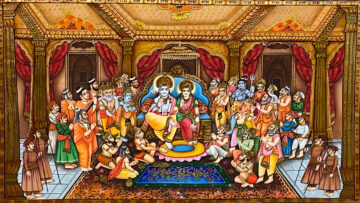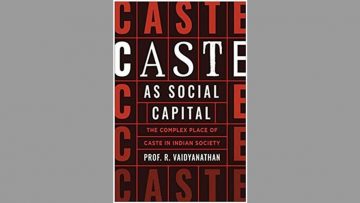Read part I here.
I. Culture and System Change
This part outlines 3 concepts that can enable and even drive system change involving Indian C&T and will use examples of lived experience and “trust circles” to illustrate and guide action.
1. Cultural Navigation
This concept describes a) individual agency to maneuver through cultural symbols, practices, beliefs represented by others in immediate and extended trust circles (family, friends, gurus, local influencers) in order to slowly bring about change in their own interest; and b) how circles of trust in family and neighborhood respond dynamically and adjust to new needs and aspirations as the economy grows. This is particularly important in managing women’s aspirations for study and career while they also simultaneously try to fulfill their roles of wife and mother.
While conducting a training program in enterprise in the state of Jharkhand, I saw Kunti Devi, a middle-aged semi-literate tribal woman, enter the rural venue with two books hidden in her saree pallu to avoid being questioned by community members in her village as to why, a woman her age, needed to go out of the house and that too for education which they believe is not much use for women. Rather than enter into an argument with her family and perhaps also be prevented from continuing the training, Kunti Devi preferred to find her mode of cultural navigation. And this practice of hiding the books in the saree pallu, Kunti Devi continued every day till she finished the training several weeks later. The ten other middle-aged tribal women who attended and completed the training like Kunti Devi, had similarly navigated through their “trust circles” by persuasion and adjustment with their household responsibilities.
It was tough for Kunti Devi to multi-task, but she believed that she would be able to earn as well as contribute to family income and that, watching her progress, her family would start sharing housework. Whether or not or when and if Kunti Devi’s family helped her is not relevant here but what is important is her belief in the validity of navigation derived from her C&T. Kunti Devi and the nine other trainees formed a solidarity group and would stay for a while after the training to discuss various political, economic and social issues affecting their village. After a year, they negotiated with local elders (retired school teacher, panchayat head, even the rich man or Sahukar of the village) to get a small room where they could hold their meetings.
These examples of cultural navigation by rural women to involve their familiar circles of trust to help disrupt resistance to their progress gradually, are seen across rural and remote India.
Kunti Devi and her group members adjusted their educational goal with their household duties and never viewed their life as a “double burden”. Double burden is a concept that developed in the western world to signify what was believed to be oppression of women who have to manage both their household work and earning for the family. Double burden and then later, “triple burden” (adding their involvement in the larger work economy such as enterprises) came to underlie the prescriptions for policy change, particularly for emerging economies.1 Burden and oppression (that includes domestic violence and abuse) are common terms in feminist literature and frame the global discourse on gender and work but are not necessarily the terms used by rural women in India to describe their daily lives. While the problems faced by poor women in trying to manage their multiple roles, particularly those who are on the edge of survival, is palpable and in need of change, C&T as the lens and navigation as the construct provide the meeting point of policy for system change and practice from below for support. Without the latter, the former cannot be brought about. Indeed, even in the United States, the 25 year-old law against violence against women has not served to reduce the incidence of violence against women. Academics there are calling for a different route.2
In urban India, where educated women aspire bigger, help in managing their aspirations with professional growth and family life comes primarily from in-laws and extended family (much maligned by feminists as patriarchal and discriminatory towards women). Successful Indian women entrepreneurs such as Naina Lal Kidwai have acknowledged that having a close knit family has been an advantage for women’s work contrasting it with the west where women are less able to depend on families for critical psycho-social motivation at start-up and physical support, such as child care, as they grow their career and families.3 Studies on women entrepreneurs in contrasting cultures of countries like India and the United States also supports this view.4 This close-knittedness of family in India is a cultural and traditional value that goes beyond providing just the basic needs of a child. Working women in India prefer family provided childcare to institutionalized childcare even when there is an option for the latter.
While calls by the United Nations for state provisioning for childcare to enable women to pursue a career is well taken,5 slippage in apportioning priorities and budgets among competing demands in emerging economies like India is a given. Even if there is more sensitive apportioning due to advocacy and pressure, the gap between demand and supply will likely remain as women’s aspirations rise. So solutions to institutionalize family support are the culturally consistent and sustainable ways for system change in India. This is apart from the value of navigation through negotiation and time adjustment in their families that career women in India already employ. Interestingly, companies in the west are realizing the importance of the child rearing function for the mothers by allowing them longer leaves and job security when they return to work.6
Another example of C&T playing a crucial role for the millennial Indian women is digital technology. Digital knowledge and use is now considered one of three crucial assets along with property and finance for gender equality by the United Nations.7 The report rightly advocates mobile phones as devices to further this objective. In India, they nicely fit culturally navigable knowledge and skills enrichment for girls, especially in states with patchy governance and safety record for women. With knowledge and information available almost at the doorstep, family support along with girls’ own motivation has become key for empowerment.
In Uttar Pradesh an organization called Jagriti has scaled a digital literacy program for young girls8. Mansi, is one of the educators in this program, currently studying for her BA in a local college, but also spreading mobile literacy to girls and young women in several villages. Her father values digital literacy as a means of education for girls so he provides Mansi the means of safe travel by taking her to villages on his two-wheeler. Other girls mention how their parents helped their learning and outreach by not questioning them over the use of a mobile phone (which, due to ease of access to unsuitable content on the internet, is often restricted by parents). Other ways of family support include siblings take over their household chores when the girls go out to teach and, significantly, male siblings providing tutorials since they have had a headstart in access to digital literacy. All this has not only widened and honed Mansi’s own expertise on mobile internet, it has stirred the family “trust” atmosphere to empower girls like Mansi to envision bigger and better prospects for themselves in enterprise. Mansi wants to start a small digitally-enabled coaching center at her home for girls and boys from the area that she and her parents hope will become a reality soon.
Mansi is shaping the contours of a business model of family-nurtured and nested enterprises consistent with Indian C&T for other aspiring young women as well. All three examples show that it is the agglomeration of forces of cultural navigation that moves the needle towards the first and most important units of system change, i.e., families and communities.
2. Cultural Care
Culture care is a hallmark of formal and informal economic relationships and services in India. They display mutuality of care and reciprocity of requirements and service that are determined by negotiation and not measurable in only financial terms. The social, political and economic requirements and services run into each other at individual and official levels. A clear demarcation of roles and functions has proven to be as impractical in the economic arena as in the social. Strict demarcation is not consistent with the informal social contract between the parties that is common in Indian C&T. The continued asymmetry in state policy, services and implementation for economic benefit of the large majority of people has increased their risk and reinforced the value of semi-formal economic relations.
Depending on definition, the size of the informal sector in India has varied from 60 to 90% in employment, enterprises and output. Informal sector is characterized by lack of written contracts and/or irregular employer-worker relationships, wage insecurity, with few or no benefits of social security, and similar inequity that causes informal sector workers to hover on the edge of poverty and have little recourse to legal redress. The informal sector dominates the Indian economy and has done so since India’s independence though the term was not coined until 1972.9The received wisdom from western trends is that the more formal the economy, the more regulated it can be in terms of tax collection and attract investment, leading to a cycle of a growth. It seems that its mixed cultural, social, political and economic relationships and imperatives defy the attempts to follow the formality that western style regulation demands.
Given that the informal sector has endured and is likely to stay, the cultural mutuality mechanisms in India in India is noteworthy. These help workers cope with the uncertainties of informality and bring in some trust in the relationship between employer and worker. An entire range of domestic care services such as cooks, elderly care, drivers, etc. rest on mutuality values, and is a social contract which blends employee wages with welfare benefits at the point of service level. These are negotiated as per requirement and schedule and include salary advances, leave for illness and marriage in the worker’s family, or support for his/her child’s education. In return, the workers, when required, offer to work beyond the designated schedule or perform tasks not earlier decided. This reciprocity is based on trust that neither side will be exploited though, it may be argued, its origins lie in patron-client relationships that began and persist under conditions of economic inequality, particularly the absence of reliable credit for informal sector workers.
Nonetheless, new age start-ups have been challenged to grow and prosper in the C&T of blended returns to labor. There is much turnover in service personnel and quality.10 There are only wage contracts and no need-based benefits in these start-ups that can match what informal relationships provide. Start-ups that have ignored or not understood how many traditional occupations are still neighborhood and social contract based in urban areas struggle or shut down. For example, ignoring the strength of the dhobi tradition, start-ups that tried to “professionalize”, i.e, formalize, laundry services, have closed. 11 Another reason for many start-ups faltering is not due to funding constraints, as is commonly argued, but the attempt to follow and replicate Western business models.12 And these models derive from Western culture and experience.
Rama Bijapurkar, a widely quoted expert on market strategy and consumer behavior and who has advised Fortune 500 companies says that in India, companies have to understand Indian culture and shed the binaries they are used to that there is “a zero sum game where there is only one winner.” The Indian consumer does not view tradition and modernity as “this or that” but constantly negotiates both.13
3. Cultural Reason
It’s a curious concept on the face of it (since culture has been held responsible for not being adaptable to changing circumstances) but actually it has its internal sense that works for the individuals that act on the basis of it. Indian culture consists of symbols, rituals, practices, that work across economical, political and social spheres. These are intrinsically in harmony with nature and their own self-interest that, critically, marries needs with responsibilities. Survival requirements that depended on nature’s bounty helped make individuals ensure that they don’t act against it. Land provided the essential sustenance for everyone and barter system worked to ensure that each got from the other what they needed. Beliefs and customs led to self-regulation and self-correction not external dictats (we have methods like meditation and scriptural tenets to help). The give and take that is characteristic of relationships in Indian culture is based on Reason and Reasonableness (with a capital R) that works for requirements and responsibilities of all who are in those relationships.
The planet was seen as a whole system where all had a function. External inducements, corporatization, large and complex value chains with a variety of intermediaries, where those who lived in harmony were removed from this Reason, has led to disharmonious practices. Investors and private sector that follow the western socio-economic frameworks driven by financial returns now say sustainability is an issue and frameworks for investment and development, i.e., system change, should also include environment and social returns. But Indian C&T are in harmony with nature. If these can be adopted as the lens for system change, global priorities could be differently arrived at and lead to a better future.
In an online survey of 18,000 people in 18 countries called Greendex, conducted in 2014 by National Geographic, India had the highest score of sustainable consumer behavior (environmental habits and attitudes in housing, transportation, food and consumer goods) and United States had the lowest. “Sustainability has always been a core component of Indian culture. Its philosophy and values have underscored a sustainable way of life.
For example, the yogic principle of aparigraha, which is a virtue of being non-attached to materialistic possessions, keeping only what is necessary at a certain stage of life. Humans and nature share a harmonious relationship, which goes as far as a reverence for various flora and fauna. This has aided biodiversity conservation efforts. Sustainable and environmentally friendly practices and psyches still continue to be part of the lifestyle and culture. India has both a culture of hoarding (in case something might come in useful), and thriftiness (re-use and hand-me-downs). It is not an uncommon sight in an Indian household to witness an old cloth being used as a duster.”14
Cultural Reason is embodied in the integration of ethical, spiritual and environment-friendliness for several communities in India in a trust-based conservation contract. The Bishnois, a Vaishnavite sect, living in western Rajasthan on the fringe of the Thar desert have, for centuries, sacrificed their lives to preserve this circle of trust which is part of their sacred traditions. The basic philosophy of this religion is that all living things have a right to survive and share all resources. In the fifteenth century, Jambhoji, a resident of a village near Jodhpur, had a vision that the cause of the drought that had hit the area and hardship that followed was caused by people’s interference with nature. Thereafter, he became a sanyasi and came to be known as Swami Jambeshwar Maharaj. This was the beginning of the Bishnoi sect. He laid down 29 tenets for his followers which included a ban on killing animals, a ban to the felling of trees – especially the khejri – which grows extensively in these areas, and using material other than wood for cremations. Nature protection was given foremost importance in these tenets. Since then, the sect has followed these tenets. Some have died for it as in1786, when the then-Maharaja of Jodhpur ordered trees to be cut in order to build his palace and the Bishnois resisted by hugging Khejri trees and 363 of them, including many women, were said to have perished in Khejarli village near Jodhpur. More recently, Bishnois succeeded in launching a high-profile case against Bollywood actor Salman Khan and others accused of shooting two black bucks in the area inhabited by Bishnois in Rajasthan. Though black buck is a protected animal and Salman was prosecuted by the state for the violation of law, the case remained in the headlines due to the Bishnoi’s sustained effort to pursue the case they had filed, derived from the belief in the trust contract to preserve nature that they had followed since the 15th century. Bishnoi villages even today are recognizable in the arid, treeless regions of Jodhpur and Bikaner by their tree and bush cover.15
Climate change is not a new phenomenon but the increasing lack of capacity to cope and the scale of its impact is new. Indian cultural Reason had enabled equity and saving principles in water provision. But these survive only in patches as newer technology for water access is not one of collection and storage but extraction (borewells and tubewells), thus depleting the resource. In India, conservation and preservation beliefs (also scripturally supported) had produced appropriate climate-resilient infrastructure such as tanks to hold rainwater and assigned responsibilities among people for maintenance and distribution. The Arthashastra laid down the responsibilities of the king and common people to preserve traditional structures to ensure that there is water year-round. The neeruganti (watermanager) in Karnataka was appointed by the village community to ensure fair distribution of irrigation water to every farmer irrespective of class or creed. Only the neeruganti had the right to decide the usage of water in the tank and its outflow to ensure equity.16 This was the traditional circle of trust in water management.
Sometimes it takes a disaster to remember and revert to our cultural Reason. Kasargod witnessed unprecedented water scarcity in 1983. The main crops like coconut, areca, banana, black pepper and paddy were damaged. The harsh lessons learnt from this made the community realise the importance of traditional kattas. Kattas are temporary structures in the form of barricades erected across rivers, streams and rivulets to hold back the flowing water. Built out of locally available stone and mud, the kattas are in existence only for three or four months in the summer. Enormous volumes of water contained by the kattas soak into the soil on both sides of the stream. This moisture, which seeps into the soil, releases itself gradually into the neighboring wells for agricultural purposes. People remembered and rebuilt traditional katas and also engaged in consultations on ways to improve and strengthen them using newer materials. Kattas are a part of local culture, and with their rejuvenation, the traditional circle of trust around sustainable water sources has also been restored.17
Culture Reason guides creation of contextually relevant eco-social environment in various communities. Housing using local bamboo material and constructed on stilts is traditional even today in flood plains of Bengal and North East India to enable inhabitants to survive during deluges. “Mutuality based social systems centered around the local moneylender, thinning of crop stands to enable better survival in dry patches, reduction in unnecessary consumption and scaling down of celebrations, asset disposal and if worst comes up then migration are some coping strategies. Communities living with events of these kinds have evolved these ways over decades and they can pretty much cope and survive with what may be termed a ‘normal bad event’ of drought or flood.”18 Men and women work all day in high temperatures in many parts of India of over 450 C in the summers and deaths are few because they have learned to cope, mentally and physically. Contrast this with a ‘heat wave’ of 410 C in Europe in the summer of 2003 that resulted in the death of over 14,000 citizens, mostly elderly people.19
The threat to food security due to climate disruption has also revived traditional knowledge and varieties of rice in crop production, some of which are not just food secure but also command a market. Examples include traditional paddy varieties (such as the kalajeera rice propagated by the Tamil Nadu-based MS Swaminathan Research Foundation that is fetching farmers a high premium) as well as millet varieties (as in Nagaland) which over the years gave way to high yielding crop varieties though traditional varieties could grow even in marginalised lands, were highly diverse in terms of pest resistance, yield, time of cultivation and maturity and water requirement. Climate threats have also revived, in tribal areas, traditional methods of mixed cultivation. For example, Baiga tribals grow as many as eight to 10 varieties of millets, corn and five varieties of legumes in a single plot. Madia tribals grow five to six millets, apart from three to four varieties of legumes. And revival of local trust circles for preservation and exchange of seeds strengthen the package of cultural Reason that can ensure sustainability.20
II. Pointers for C&T-based System Change
S.N. Balagangadhara and Divya Jhingran call traditions as performative knowledge, as a collection of ceremonies, festivals, civic functions and rituals socially and interactively experienced and transmitted over generations.21 If performative knowledge is diverse and operates through similarly wide interpretation and expression, then there is already a problem of asymmetry in conception of a distinct nationhood except through acknowledging this diversity and accepting system change as a process of working our way through dynamic collision, creation and consolidation within and outside Indian C&T. Even the process of change in these traditions, as shown in this paper, is internal to them and these traditions have their own Reason and understanding of Reasonableness, expectations of support, as well as approach and pace of navigation, as they encounter new ideas, concepts, and experiences. This is as true within the non-composite Indian C&T, as it is of influence of non-Indian C&T on Indian C&T.
System change in India is and will sustainably be anchored in circles of trust that derive their strength from the C&T in which they are embedded. They are reliable for their capacity to flex with the agency of the individual citizen and in dealing with externalities that tug at enhancing capacity with minimal conflict. These circles are enduring for system change and their modalities of management and forward movement, some of which are described in this paper, are models to be fostered and followed, particularly now that there is much acknowledgement globally that trust in institutions of governance and service delivery is at an all time low.22
What would some elements of Indian C&T-based models be?
i. Institutionalized blending of formal and informal within and between organizations, enterprises and financiers.
The optimum blend will vary according to each case; the point, however, is to recognize blending as a “good practice” of sustainable organizations and operations that are rooted in Indian C&T. In modern enterprise, these models will be not big monopolies (as in the west) but an agglomeration of large numbers of smaller units, geographically and culturally spread out and that collaborate organically by expanding their circles of trust. Development economists attribute the persistence of the informal sector in India to the format of modern capitalism where corporate greed contracts out labor in order to reduce the required compliance for minimum wages and social security. A C&T lens will enable us to view informality’s navigation contribution positively and conceive of alternative models (that build in the full range of support including relevant policy) to integrate the vast numbers in rural India into the growing Indian economy. Though not explicitly derived from a C&T lens, some of this thinking is already in evidence in entrepreneurship discussions in India and mentioned in the context of the imperative of job creation for the large numbers of the poor, which big companies have so far not managed to accomplish.23
ii. Collaboration is facilitated by “Practical Heuristics”24 in Indian C&T
The scale of economic, social, environment needs and capacity is increasing and C&Ts across the world have to be able to meet them. In this paper, we have reviewed the limitations of western constructs to meet these challenges despite the [belated] efforts in the west to address these issues. Tactical collaboration is encouraged in western narratives as the way forward. In Indian C&T, collaboration is embedded where it is linked by “practical heuristics” that are based on evidence of interaction and exchanges and on which collaboration can be anchored. These practical heuristics promote, and are promoted through, circles of trust. And these can have development benefits for the future. One of the circles of trust in Indian C&T is the family though western C&T-based narratives have viewed it with skepticism and even suspicion as a unit for change. A government, donor and NGO partnered pilot initiative in a tribal hamlet in Rajasthan has, however, involved the families for improved nutrition for all members (particularly for the previously nutritionally deficient and neglected woman in the family). It used data to identify villages that had high rates of malnutrition, then gained knowledge directly from the families of their traditional practices around food consumption and production including what they valued and what they did not and why. Then the project identified nutrition educators from the community who could be made aware of newer practices and bring about incremental change in the families, including changing the practice of women eating last to the whole family having one meal together.25
iii. Adaptation to change by Indian C&T-compatible design not acquiescence.
Beliefs and actions in a variety of personal and professional relationships noted in this paper will be important as circles of trust expand and should to be understood and promoted as best practices. Jugaad, a popular Hindi word, has been elevated and even celebrated by western management specialists to mean improvisation in the face of management challenges. However, these challenges are against a standard that they have understood and promoted as being the “right” one. Many management approaches derived from Indian C&T are not Jugaad at all but core beliefs. On being asked on how he managed with just two aides when the American side had a large number of lawyers in the negotiating room India’s former foreign secretary S. Jaishankar, on one of his official visits to the US, is reported to have remarked “We are Indian you know. We make do.”26 And “making do” is a generational standard of Indian C&T that will have to permeate sustainability approaches in India and across the world if future generations are to prosper. A related generational standard in Indian C&T that has lessons for western standards of cost (and purpose) was shown [by the much written about] low cost of 450 crores for the Mangalyaan Mars Orbiter Mission in 2014. Frugal investments, optimizing resources, cross-utilizing components are some the methods used by ISRO throughout its history consistent with its purpose of furthering social and economic advancement of and by India. As Dr. V. Siddhartha, a strategic technology analyst who had spent many years with ISRO said, “We don’t need to explain why our budgets are low — they (other space agencies) need to explain why their budgets are so high.”27
Big-data and technology has become very attractive for cost-reduction and predictability for the state to know what people need and how to provide it. India’s policy makers are keenly interested in this and are going forward with the necessary means. But aspirations below will gallop at a faster pace and it will be our C&T and circles of trust that will help to smoothen the inevitable gaps and provide the Reason.
References
1. UNDP, Fast-Forwarding Gender Equality and Women’s Empowerment, Independent Evaluation Office Occasional Paper, 2014
2. Viswanath, Vanita, One Size Does Not Fit All, Swarajya, March 9, 2016
3. Kidwai, Naina Lal (ed), 30 Women in Power, Rupa, 2015 Vandana Aggarwal of Boston Consulting Group in an interview
4. Khandelwal and Sehgal, “Exploring work-family interface for Indian women entrepreneurs”, Gender in Management, 2018
5. UN Secretary General’s High Level Panel on Women’s Economic Empowerment, Leave No One Behind Taking Action For Transformational Change On Women’s Economic Empowerment, 2017
6. https://www.forbes.com/sites/karstenstrauss/2017/09/26/the-100-best-companies-for-women-and-working-families-in-2017/#37573fd7889e
7. UN Women, Report on Gender Equality, 2016
8. This author is a board member of Jagriti and was advising this program.
9. Data on household enterprises that form part of the informal economy appeared in very first National Sample Survey of India (NSS) in October 1950. NSS data collection and analysis on informal enterprises has been going on since then.
10. https://bit.ly/31Ss2CG
11. Velayanikal, Malavika https://www.techinasia.com/why-indias-largest-and-best-funded-laundry-startup-doormint-shuts-shop
12. https://www.forbes.com/sites/suparnadutt/2017/05/18/startups-in-india-fail-due-lack-of-innovation-according-to-a-new-ibm-study/#38c33262657b
13. Bijapurkar, Rama, We are Like That Only; Understanding the logic of Consumer India, Penguin, 2007, p168
14. https://www.weforum.org/agenda /2017/10/what-india-can-teach-the-world-about-sustainability/)
15. Shekhawat, Prahlad Singh, https://www.downtoearth.org.in/blog/the-power-of-community-60245, April 19, 2018
16. Reddy, Dr. S.T. Somashekara, Water Management: The Neeruganti Way in Sandhya Iyengar ed, Waternama: A Collection of traditional practices for water conservation and management in Karnataka, 2007, http://www.indiawaterportal.org/sites/indiawaterportal.org/file/Waternama_english.pdf.
17. Etadka, Chandrasekhar, Traditional Kattas, Cradles of water conservation, in Sandhya Iyengar ed., Waternama: A Collection of traditional practices for water conservation and management in Karnataka, 2007, http://www.indiawaterportal.org/sites/indiawaterportal.org/files/Waternama_english.pdf
18. Phansalkar, Sanjiv, India’s traditional wisdom in coping with extreme weather, Village Square, https://www.villagesquare.in/2018/09/05/indias-traditional-wisdom-is-coping-with-extreme-weather/
19. Phansalkar, n. 27
20. Pallavi, Aparna, https://www.downtoearth.org.in/news/how-central-indian-tribes-cope-with-climate-change-impacts-43226. 17 August 2015.
21. Balagangadhara, S.N and Jhagran, Divya, Do all Roads lead to Jerusalem? The Making of Indian Religions, Manohar, 2014
22. Khanna, Tarun, Trust: Creating the Foundation for Entrepreneurship in Developing Countries, Berrett-Koehler Publishers, Inc, California, 2018
23. GAME is one such initiative created in 2018 by Ravi Venkatesan, ex-Microsoft, who will work with partners to enable “mass entrepreneurship” i.e. creating millions of local businesses that typically hire five or more people, use local inputs and serve local needs. https://bit.ly/2RI6uE3
24. de Roover, Jakob, Europe, India and the Limits of Secularism, Oxford University Press, 2015
25. Pal, Sanchari, How the Simple Act of Eating Together is Tackling Malnutrition in Rural India, https://www.thebetterindia.com/120186/malnutrition-sustainable-development-goal-un-rural-india-freedom-from-hunger/
26. Datta-Ray, Deep, The Making of Indian Diplomacy, A critique of Eurocentrism, Oxford University Press, 2015
27. https://www.telegraphindia.com/india/shoestring-chutzpah-they-should-say-why-their-budgets-are-so-high/cid/1579660
(Note: Indic Academy supported the author to attend the Conference on Indian Culture vs. Western Culture at IIM Kozhikode. This series is part of the work presented by the author at the Conference.)
Disclaimer: The opinions expressed in this article belong to the author. Indic Today is neither responsible nor liable for the accuracy, completeness, suitability, or validity of any information in the article.










